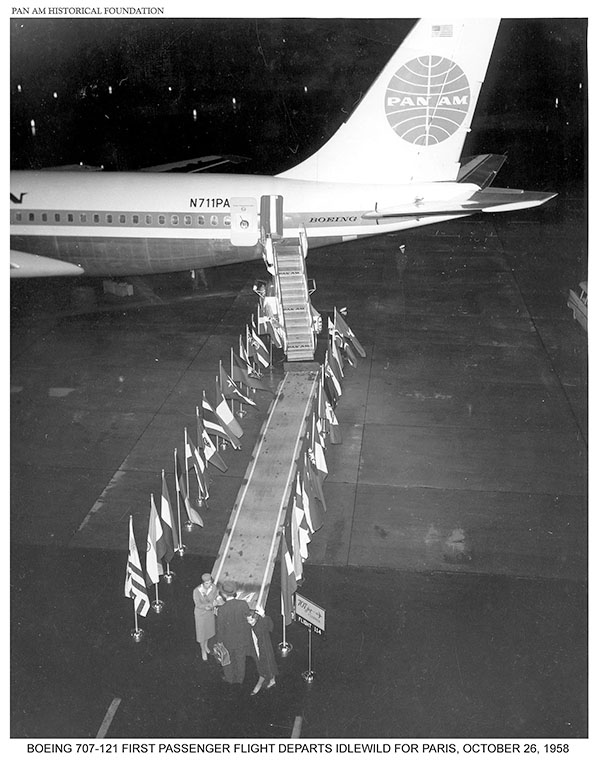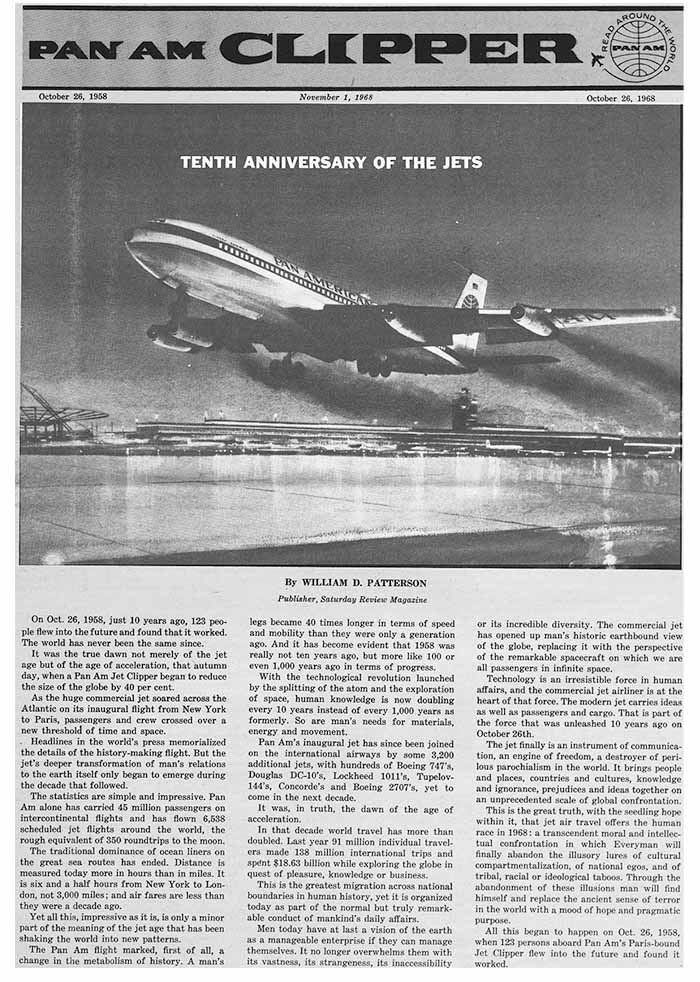TENTH ANNIVERSARY OF THE JETS
By William D. Patterson
Publisher, Saturday Review Magazine
On Oct. 26, 1968, just 10 years ago, 123 people flew into the future and found that it worked. The world has never been the same since.
It was the true dawn not merely of the jet age but of the age of acceleration, that autumn day, when a Pan Am Jet Clipper began to reduce the size of the globe by 40 per cent.
As the huge commercial jet soared across the Atlantic on its inaugural flight from New York to Paris, passengers and crew crossed over n new threshold of time and space.
Headlines in the world's press memorialized the details of the history-making flight. But the jet's deeper transformation of man's relations to the earth itself only began to emerge during the decade that followed.

The statistics are simple and impressive. Pan Am alone has carried 45 million passengers on intercontinental fights and has flown 6,538 scheduled jet flights around the world, the rough equivalent of 350 roundtrips to the moon.
The traditional dominance of ocean liners on the great sea routes has ended. Distance is measured today more in hours than in miles. It is six and a half hours from New York to London, not 3,000 miles; and air fares are less than they were a decade ago.
Yet all this, impressive as it is, is only a minor part of the meaning of the jet age that has been shaking the world into new patterns.
The Pan Am fight marked, first of all, a change in the metabolism of history. A man's legs became 40 times longer in terms of speed and mobility than they were only a generation ago. And it has become evident that 1958 was really not ten years ago, but more like 100 or even 1,000 years ago in terms of progress.
With the technological revolution launched by the splitting of the atom and the exploration of space, human knowledge is now doubling every 10 years instead of every 1,000 years As formerly. So are man's needs for materials, energy and movement.
Pan Am's inaugural jet has since been joined on the international airways by some 3,200 additional jets, with hundreds of Boeing 747's, Douglas DC-10's, Lockheed 1011's, Tupelov-144's, Concorde's and Boeing 2707s, yet to come in the next decade.

It was, in truth, the dawn of the age of acceleration.
In that decade world travel has more than doubled. Last year 91 million individual travelers made 138 million international trips and spent $18.63 billion while exploring the globe in quest of pleasure, knowledge or business.
This is the greatest migration across national boundaries in human history, yet it is organized today as part of the normal but truly remarkable conduct of mankind's daily affairs.

Men today have at last a vision of the earth as a manageable enterprise if they can manage themselves. It no longer overwhelms them with its vastness, its strangeness, its inaccessibility or its incredible diversity. The commercial jet has opened up man's historic earthbound view of the globe, replacing it with the perspective of the remarkable spacecraft on which we are all passengers in infinite space.
Technology is an irresistible force in human affairs, and the commercial jet airliner in at the heart of that force. The modern jet carries ideas as well as passengers and cargo. That is part of the force that was unleashed 10 years ago on October 26th.
The jet finally is an instrument of communication, an engine of freedom, a destroyer of perilous parochialism in the world. It brings people and places, countries and cultures, knowledge and ignorance, prejudices and idea together on an unprecedented scale of global confrontation.
This is the great truth, with the seedling hope within it, that jet air travel offers the human race in 1968: a transcendent moral and intellectual confrontation in which Everyman will finally abandon the illusory lures of cultural compartmentalization, of national egos, and of tribal, racial or ideological taboos. Through the abandonment of these illusions man will find himself and replace the ancient sense of terror in the world with a mood of hope and pragmatic purpose.
All this began to happen on Oct. 26, 1958, when 123 persons aboard Pan Am's Paris-bound Jet Clipper flew into the future and found it worked.
Related Articles:




